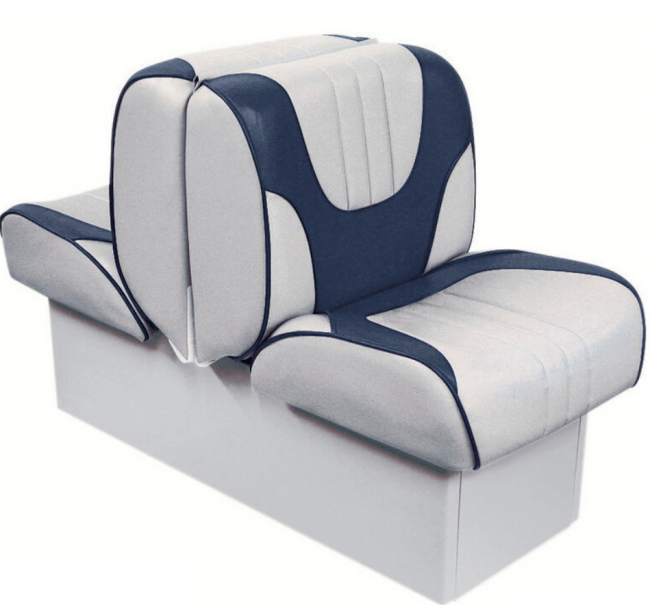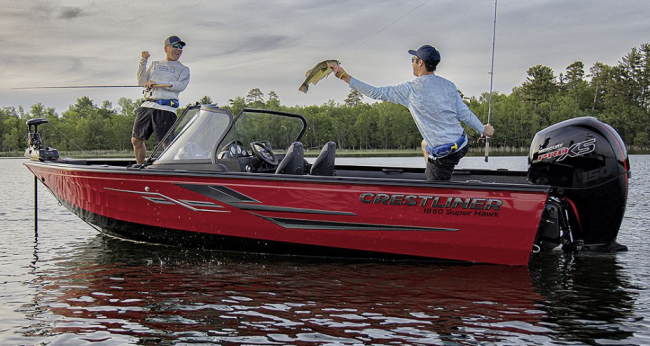
Buying a boat can be a daunting experience, especially if you don't really know in the first place exactly what you want. Buying a boat isn't really that hard. Buying the right boat that suits your needs just takes a little more time.
Make the wrong choice and you probably will not enjoy your boating. Make the right choice and it will be hard to keep you off the water. The problem is there are so many models that you have to work through a process of elimination to even get to the final few.
The important thing is that when you are comparing boats of a like size then you must find out exactly what you are paying for. Don't disregard one particular brand from another because there is a $3000 price difference, before first comparing everything from the seating options to the bilge pump.

Back-to-Back seats, like those pictured above, are more expensive than pedestal-style seats - but much more comfortable. This may seem like a small detail, but these small details can greatly affect your boating experience.
Back-to-back seats are more expensive than pedestals and an underfloor fuel tank or bimini top can make a big difference to the final price when buying a boat. It also may be a fully packaged boat that will include the boat, motor and trailer.
If you're buying a boat that carries the Marine Industries Association CPC plate it means that it is officially certified as complying with the CPC code of quality assurance in building and equipment. Standard features on all CPC-rated boats include an electrical switch panel, fuel system, navigation lights, bilge pump, battery cut-off switch, battery box, minimum 2-year hull structure warranty and a maximum horsepower rating.
The Coastguard-approved CPC compliance code is like a warrant of fitness on the water for new boats and supported by many of New Zealand's major boat builders in both aluminum and fiberglass.
Which Style?
When deciding you are going to look for a new or second-hand boat, the first decision to make is what type of boat you want. While every boat is somewhat of a compromise, if you are planning to spend most of your time offshore fishing, then you should be looking at a hardtop.
On the other hand if you plan to spend your days towing water toys on Lake Karapiro then your first choice should be a specialist American ski/wake boat. The following is a brief description of the different styles of boats.
Runabout Boats - Runabouts are open except for a foredeck. They come in a variety of guises and are virtually all outboard-powered. Aluminum runabouts are mostly targeted toward the fisherman, looking for a light, easy-to-handle open boat for sheltered water fishing.

Sports cabin boats are also great for someone who wants to skip the splashing and rainy weather.
Sports Cabin Boats - New to the market are the sports-cabin boats that look like runabouts from the outside but successfully incorporate a small cabin area under the foredeck.
Ski/Wakeboard Boats - Totally specialist in their design and fit-out, the new breed of American and Australian ski/wakeboard boats are dedicated to skiing and wakeboarding. Not the sort of boat you buy to fish off the West Coast.
Bowrider Boats - A bowrider is a runabout with a walk-through windscreen and no foredeck! The area is replaced with wrap-around seating. This style of boat has been made popular by American manufacturers, where they are the largest-selling style of trailerboat in North America. The major benefit is a boat that provides maximum use of space from the transom to the bow.
Cuddy Cabin Boats - This is another name for a half-cabin or semi-cabin, where the enclosed area forward of the driver's bulkhead is too short to accommodate full-length berths. There is usually sitting headroom for one or two people and either short-side squabs or no squabs at all. The space is best used for dry storage and is not suitable for overnighting.
Cabin Boats - To be a full-size cabin there should be berths of around 1.6m to 2m long and sitting headroom for 3-4 people. The smaller the boat the smaller the cabin, but it is surprising what a good design of cabin/cockpit can achieve. It's also possible in larger cabin boats to include a toilet under the squab.

Hardtops have recently become very popular.
Hardtop Boats - While a few years ago hardtops were few, today they are almost the norm on larger trailerboats. This is especially so with aluminum boats and there are now few built over 7m that are not a hardtop. The hardtop, be it aluminum or fiberglass comes in two forms; semi-enclosed or fully enclosed and are basically just a lid on the forward section of the cockpit.
Walkaround Boats - Again, the walkaround is a style of boat that has been developed for fishermen, who require maximum space and workable cockpit area, yet want a true weekender that provides plenty of internal comfort. The walkaround derives its name from the ability to be able to walk around the outside of the cabin.
Centre Console Boats - Production fiberglass and aluminum center console boats have never been that popular in New Zealand, but when it comes to inflatables they are market leaders. The center console is a separate helm station – usually a fiberglass molding – in the cockpit that provides a basis for the steering, instrumentation, electronics, etc and doubles as a storage locker.

Open Boats
These are boats that are, as the name suggests, completely open. Examples are big dories, oversized dinghies and a lot of inflatables. They are usually tiller-steered and serve a multitude of purposes from boat tenders to laying fishing nets.
Hull Material Choice
This is where you can make the split if the list that follows is just too daunting. There are two main mediums of boat construction, aluminum and fiberglass. However, there is also polyethylene to consider and there are the inflatable RIBs which are based on either aluminum or fiberglass hulls with fabric tubes around the outside. So what are the main differences between them?
Aluminum Boats:

Aluminum boats are lighter than fiberglass - which can be an advantage depending on what you're looking for.
There are some who say that if you are really serious about your fishing then you have to have an aluminum boat. While there are certainly advantages, the fact is you can fish from anything and just because it's alloy doesn't mean it's going to catch you any more fish or be better to fish from.
Aluminum boats are either constructed with plate or pressed aluminum. Plate boats are just what they say, plates of aluminum, cut and welded together to form the hull, deck, bulkheads and superstructure.
Aluminum boats are not indestructible and do require maintenance. If they are unpainted then you should consider getting the factory to at least give them a Nyalic coating. This adds a clear protective film over the hull and stops the alloy from dulling and looking well used after only a few times on the water.
Like any boat, they should be washed thoroughly with fresh water after every use if you want them to retain their good looks.
Being lighter has the advantage of being powered by a smaller horsepower engine and therefore less initial financial outlay and running costs. It also means you don't need a big tow car to move it around – unless you're into something over 7m.
Fiberglass Boats

Fiberglass is the other popular building medium for boats - and has some key differences.
New Zealanders have taken to fiberglass or grp – glass reinforced plastic – since the first boats were built in the early 1960s by Christchurch-based Arnold France and a few years later by Frank Simpson's Fi Glass Boats. However while the construction materials and the way it is applied has been perfected and changed over the years, the basic concept of building a boat from a mold has not.
For manufacturers to bring new models to market requires a huge investment in developing new plugs and molds. Because of this it is not uncommon to see boats that are over 20 years old still being produced. There may be a name change or even a new deck, but the basic hulls have remained unchanged.
The fiberglass boat in many ways is no different to an aluminum boat when it comes to style and appointments. The big difference is that with a molded fiberglass boat, what you see is what you get. There is little room for serious changes, like a walkthrough transom, different cabin height or special storage lockers.
Fibreglass boats of a similar size are heavier and do require plenty of TLC to keep them in top trim. Leave a fiberglass boat untouched and outside in the sun for long enough and the gelcoat starts to craze and oxidize. The beauty is it can be restored to its former glory with the right gelcoat cutters and with no effect on its structural integrity.
Just because it's built of fiberglass and looks a little flashier than an aluminum boat it doesn't mean you have to treat it with kid gloves! Materials are almost bulletproof and like any boat require no more than a simple clean up after use.
Well-built fiberglass boats often last for more than 30 years, and even when the gelcoat is chipped and chalked from long exposure to hard knocks and the elements, it can be cleaned, filled, sanded and painted with modern two-pot polyurethane to look better than new.
Polyethylene Boats

Polyethylene has been a popular medium for dinghies for years - but is now expanding to larger boats.
This is a building medium that is somewhat new to the trailerboat market, although has been around in the manufacture of canoes and small dinghies for a number of years. There are two main producers of 'plastic' boats in New Zealand and both offer a wide range of vessels from open runabouts to cuddy cabins.
Polyethylene boats are built in a huge oven where tiny polyethylene beads are put into an aluminum mold and heated and as the mold is rotated the liquid polyethylene runs around the mold to form the finished boat. After the cooling process, the basic boat is then fitted with the external hardware and its ready to rig.
They have become very popular for their hard-wearing and durability and will take plenty of hard knocks from rocks or coral. They are a little heavier than a similar-sized RIB or aluminum dinghy or open runabout.
Hopefully, this has helped you understand your options when buying a boat.












